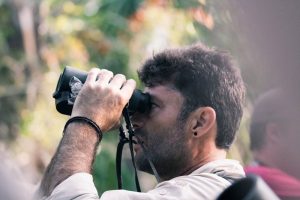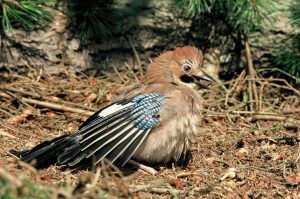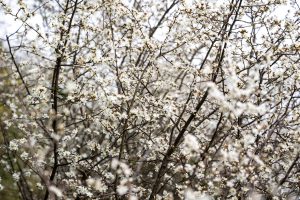Ever considered becoming a citizen scientist?
The term ‘citizen science' covers a wide range of subjects, from identifying diseased trees to monitoring the activities of bats, using a moth trap to better identify species and numbers and, of course, birding. These and many more areas of wildlife provide citizen scientists with the opportunity to input data, and in doing so contribute towards the body of hugely important data used by academics, scientists and biologists in their research. This information is invaluable, and for those of us whose primary interest is in bird life, one of the largest research-based organisation is the British Trust for Ornithology.
For anyone who hasn't looked into the work of the BTO - they have a number of ongoing surveys covering anything from the more common garden birds through to wetland bird surveys, and from migration focused data gathering to the ringing of birds by trained and certified ringers. But there's a good chance that there are many people who are interested in birds, and who would like to take part, but are put off by the thought that, ‘surveying is for experts’. Well, if this is what's putting you off then a current survey might just be the one to get you interested and involved.
The Tawny Owl Point Survey is an ideal way to get you started as it only takes a few visits to a location and, once there, only requires you to be on site for 20 minutes per visit. What's more, you don't have to see the owls, just hear them. The survey runs from 15th August to 15th October with the likelihood that it will be repeated in February 2019. It could also be repeated in the autumn of 2019 if the funding is available, so even if you miss this year's survey, there could well be other opportunities in the future.
The Tawny Owl Point Survey would seem to be ideal for anyone who would like to contribute towards the data held on this well-known owl, about whom we know very little when it comes to population and distribution. But quite apart from the valuable data that you will be gathering (even if you don't hear an owl) what this survey could do is act as an introduction to bird surveying.
The RSPB's Big Garden Bird Watch, which will be 40 years old next year, is also a great place to start recording visitors to your own garden but this is only a snapshot. Survey's, like those organised by the BTO, are ongoing and enable garden birdwatchers to record details of visitors throughout the different seasons. This is all hugely important data. And it's not just information on the birds visiting that is required. Details of the numbers of other animals and the food they have on offer is also valuable, it all adds to the overall picture.
So if you are considering taking part in a survey, I suggest you take a look at the BTO's website and maybe even drop a line to your regional representative to find out more. Don't be put off by thinking that your id skills are not up to it - they probably are. And if you feel they may not be there are loads of resources online to help you. You don't have to look further than this website, under the Advice & Blog section to find information on the birds you could well see in your own garden. And just because it is your garden don't think it's not important. Without the data gathered by thousands of birders across the country we'd have no idea as to just how perilous a situation our wildlife is currently in.
But if you are still not convinced that bird surveys are for you why not give the Tawny Owl Point Survey a try? Visit the website and see if there is a location close to you that you could cover. The information you provide will be as valuable as the food you provide for the birds that visit your feeders.
© Phil Pickin
BTO: www.bto.org
Tawny Owl Point Survey: https://www.bto.org/volunteer-surveys/project-owl/tawny-owl-point-survey
RSPB Garden Bird Watch: https://www.rspb.org.uk/get-involved/activities/birdwatch/
For anyone who hasn't looked into the work of the BTO - they have a number of ongoing surveys covering anything from the more common garden birds through to wetland bird surveys, and from migration focused data gathering to the ringing of birds by trained and certified ringers. But there's a good chance that there are many people who are interested in birds, and who would like to take part, but are put off by the thought that, ‘surveying is for experts’. Well, if this is what's putting you off then a current survey might just be the one to get you interested and involved.
The Tawny Owl Point Survey is an ideal way to get you started as it only takes a few visits to a location and, once there, only requires you to be on site for 20 minutes per visit. What's more, you don't have to see the owls, just hear them. The survey runs from 15th August to 15th October with the likelihood that it will be repeated in February 2019. It could also be repeated in the autumn of 2019 if the funding is available, so even if you miss this year's survey, there could well be other opportunities in the future.
The Tawny Owl Point Survey would seem to be ideal for anyone who would like to contribute towards the data held on this well-known owl, about whom we know very little when it comes to population and distribution. But quite apart from the valuable data that you will be gathering (even if you don't hear an owl) what this survey could do is act as an introduction to bird surveying.
The RSPB's Big Garden Bird Watch, which will be 40 years old next year, is also a great place to start recording visitors to your own garden but this is only a snapshot. Survey's, like those organised by the BTO, are ongoing and enable garden birdwatchers to record details of visitors throughout the different seasons. This is all hugely important data. And it's not just information on the birds visiting that is required. Details of the numbers of other animals and the food they have on offer is also valuable, it all adds to the overall picture.
So if you are considering taking part in a survey, I suggest you take a look at the BTO's website and maybe even drop a line to your regional representative to find out more. Don't be put off by thinking that your id skills are not up to it - they probably are. And if you feel they may not be there are loads of resources online to help you. You don't have to look further than this website, under the Advice & Blog section to find information on the birds you could well see in your own garden. And just because it is your garden don't think it's not important. Without the data gathered by thousands of birders across the country we'd have no idea as to just how perilous a situation our wildlife is currently in.
But if you are still not convinced that bird surveys are for you why not give the Tawny Owl Point Survey a try? Visit the website and see if there is a location close to you that you could cover. The information you provide will be as valuable as the food you provide for the birds that visit your feeders.
© Phil Pickin
BTO: www.bto.org
Tawny Owl Point Survey: https://www.bto.org/volunteer-surveys/project-owl/tawny-owl-point-survey
RSPB Garden Bird Watch: https://www.rspb.org.uk/get-involved/activities/birdwatch/



